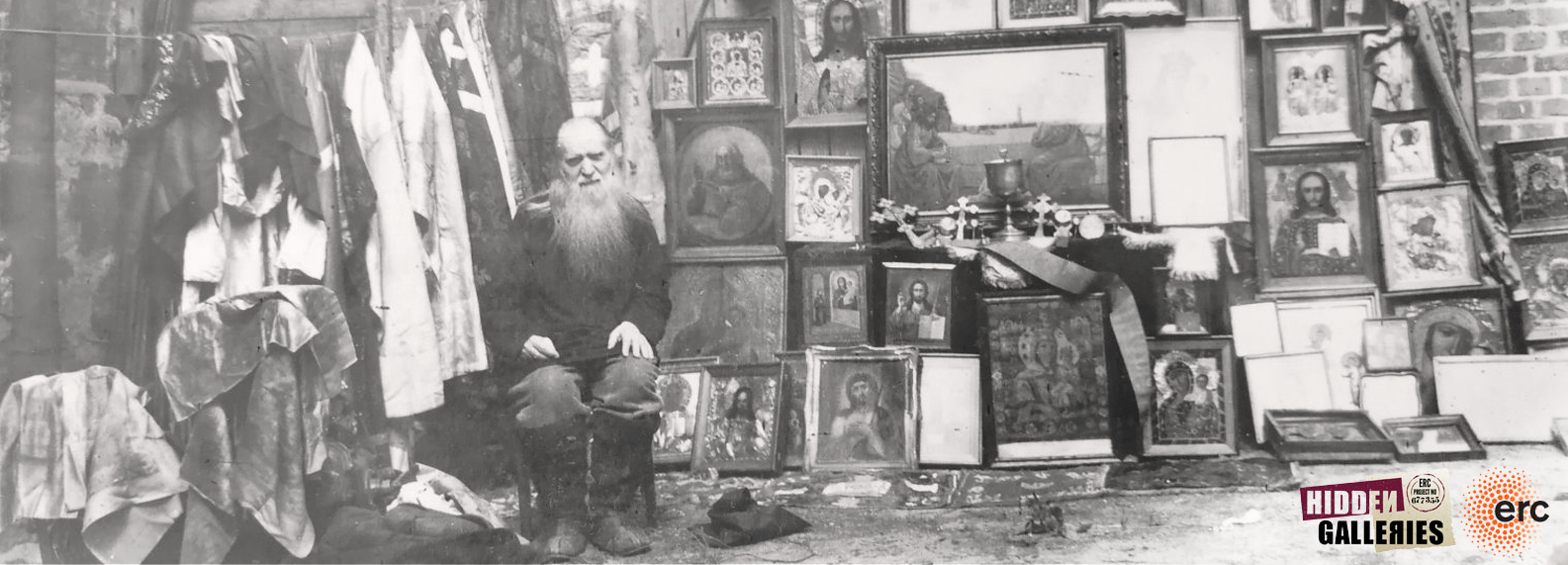National Archives of the Republic of Moldova
Item set
Title
National Archives of the Republic of Moldova
Archiva Națională a Republicii Moldova (ANRM)
Description
1. History of Foundation
The National Archive of the Republic of Moldova (ANRM) was created on 3 December 1990 following the merger of the Central State Archive of MSSR with the Central State Archive for photo-cinema documents, which had been established in 1977.
2. Legal Commission and Task
ANRM operates in accordance with the following regulations: Regulation on the organisation and functioning of the State Archive (approved by the Government Decision nr. 695, September 14, 2012); Law nr. 880, January 22, 1992 on the Archival Fund of the Republic of Moldova; State Archive Fund Regulation (approved by Government Decision no. 352 of May 27, 1992); Law no.133 of July 8, 2011 on the protection of personal data.
3. Material relevant to the study of religions
The National Archive preserves documents relating to the political, economic, social and cultural life of Moldova from XV century to the beginning of the XXI century. There are a wide range of documents related to the history of Bessarabia as part of Romania (1918-1940, 1941-1944). The history of Moldavian Soviet Socialist Republic (MSSR) since 1940 is reflected in the documents of the central administration, ministries, state committees and commissions, prosecution and judiciary bodies, industrial enterprises, cultural and educational institutions.
In relation to the regulation, policing and repression of religion, in addition to the fond R-3401 transferred from Archives of the Information and Security Services of the Republic of Moldova (see entry Archives of the Information and Security Services of the Republic of Moldova), the archive also contains fonds relating to the policing, judicial and military judicial processes and state security aspects of the regulation of religious communities from the interwar period and wartime period Romania including fonds of the Director General of Police and the Security Service (1898-1942); Regional Inspectorate of the Security Services of Bessarabia (1919-1944); County Police Archives; Inspector General of the Gendarmerie and the archives of local gendarme commands, sections and posts and Records of the Military Tribunals of the Romanian 2nd, 3rd and 4th Armies.
The National Archive of the Republic of Moldova (ANRM) was created on 3 December 1990 following the merger of the Central State Archive of MSSR with the Central State Archive for photo-cinema documents, which had been established in 1977.
2. Legal Commission and Task
ANRM operates in accordance with the following regulations: Regulation on the organisation and functioning of the State Archive (approved by the Government Decision nr. 695, September 14, 2012); Law nr. 880, January 22, 1992 on the Archival Fund of the Republic of Moldova; State Archive Fund Regulation (approved by Government Decision no. 352 of May 27, 1992); Law no.133 of July 8, 2011 on the protection of personal data.
3. Material relevant to the study of religions
The National Archive preserves documents relating to the political, economic, social and cultural life of Moldova from XV century to the beginning of the XXI century. There are a wide range of documents related to the history of Bessarabia as part of Romania (1918-1940, 1941-1944). The history of Moldavian Soviet Socialist Republic (MSSR) since 1940 is reflected in the documents of the central administration, ministries, state committees and commissions, prosecution and judiciary bodies, industrial enterprises, cultural and educational institutions.
In relation to the regulation, policing and repression of religion, in addition to the fond R-3401 transferred from Archives of the Information and Security Services of the Republic of Moldova (see entry Archives of the Information and Security Services of the Republic of Moldova), the archive also contains fonds relating to the policing, judicial and military judicial processes and state security aspects of the regulation of religious communities from the interwar period and wartime period Romania including fonds of the Director General of Police and the Security Service (1898-1942); Regional Inspectorate of the Security Services of Bessarabia (1919-1944); County Police Archives; Inspector General of the Gendarmerie and the archives of local gendarme commands, sections and posts and Records of the Military Tribunals of the Romanian 2nd, 3rd and 4th Armies.
Of these archival sources the Records of Military Tribunals include several case files of sectarians, including Inochentists, Baptists and Adventists, who stood trial in the 1930s and early 1940s. Some of these case files contain confiscated religious materials including photographs, booklets, postcards, hymns and drawings.
The archive also holds a several fonds of Soviet institutions that were involved in the repression and surveillance of religious groups in Moldavian SSR. Apart for documentary collections relating to the activity of Militia (civil police), procuracy and judiciary agencies, the archive holds the fonds of the offices of MSSR’s Plenipotentiaries for Religious Affairs which had overseen and controlled the life of registered religious communities in the decades are WWII. Additionally, the archive preserves the protocols of extrajudicial organs of repression (Troikas) of MASSR from the period of mass repression of the late 1930s. The protocols contain names of victims of repression, a brief mention of the accusations and personal data and the sentence. The inventory of fond R-3401 does not contain details regarding the accusations or the causes of arrest of the victims. The protocols of Troikas can be used for identifying names of religious leaders and believers that can be searched in the inventory of R-3401 in order to identify any corresponding case files.
The guide to these fonds can be found here:
The archive also holds a several fonds of Soviet institutions that were involved in the repression and surveillance of religious groups in Moldavian SSR. Apart for documentary collections relating to the activity of Militia (civil police), procuracy and judiciary agencies, the archive holds the fonds of the offices of MSSR’s Plenipotentiaries for Religious Affairs which had overseen and controlled the life of registered religious communities in the decades are WWII. Additionally, the archive preserves the protocols of extrajudicial organs of repression (Troikas) of MASSR from the period of mass repression of the late 1930s. The protocols contain names of victims of repression, a brief mention of the accusations and personal data and the sentence. The inventory of fond R-3401 does not contain details regarding the accusations or the causes of arrest of the victims. The protocols of Troikas can be used for identifying names of religious leaders and believers that can be searched in the inventory of R-3401 in order to identify any corresponding case files.
The guide to these fonds can be found here:
4. Access for Researchers
Access to the archive is open to researchers and is free. An application needs to be submitted with a letter of recommendation from an institute or university. An ID card is then issued within 3 days that is valid for one year. In the case of the archival fonds belonging to present day state agencies, such as the Ministry of Justice, or Procuracy, a special permission from the administration of this institutions may be required.
Creator
James Kapaló and Dumitru Lisnic
Items
-
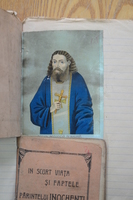
Postcard-icon of Feodosie Levițchi
This postcard icon portrays Feodosie Levițchi (Romanian spelling) or Teodosie Levitsky (in Russian) (1791-1845), of Balta (today’s Odessa Oblast, Ukraine). It was confiscated from a Bessarabian peasant in 1938 who had been charged with Inochentist propaganda and sentenced to 45 days imprisonment. Feodosie was an important figure for the Inochentist movement as Inochentie of Balta (1875-1917) was instrumental in sponsoring the cult of his deceased predecessor and distributed mass produced icons (like the one seen here) and miracle stories across Ukraine and Bessarabia to encourage pilgrims to v -
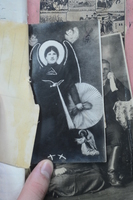
Photo-icon of Alexandru Culeac as the Archangel Michael Bessarabia
The three images presented here all show variants of the same photo-icon of Alexandru Culeac portrayed as the Archangel Michael. In the first image he appears alone; in the second image, his photograph appears next to that of Inochentie of Balta, and the third image is a reproduction of the photo-icon that appears inside the front cover of a booklet containing Alexandru Culeac's visions entitled "A vision that appeared in 1920". The presence of multiple examples of this photo-icon in the same file reflects the importance of this devotional image to the Archangelist community. Archangelism fo -
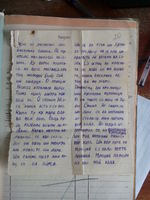
Confiscated handwritten Inochentist hymn Moldova
The images show an Inochentist handwritten hymn found by the Soviet secret police officers on an arrested Inochentist preacher in 1952 in Moldova. The hymn describes Jesus's preaching to his followers on the Mount of Olives about the End Time. The Apocalypse, according to the hymn, will begin when people would abandon the church. Then, according to the narrative, the wrath of God would descend on sinners and only those who do not abandon the true faith will be saved. The hymn is written in Romanian using the Cyrillic script. The preacher, who may not be the author of the text but was probably -
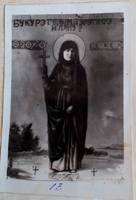
Confiscated images of Archangelist women Moldova
These photographs were confiscated by the secret police of the Moldavian SSR from a community of Archangelists in 1952. Archangelism inherited the iconographic tradition of Eastern Christianity and developed them creatively using modern techniques of photograph, photocopying, collage and multiplication. The first image was produced using the technique of photo collage. The creator of the image has utilised a copy of an Orthodox icon showing a female saint replacing the face of the saint with a photograph of the face of Elena Culiac, venerated by Archangelists as the embodiment of Virgin Mary o -

Newspaper as evidence of "collaborationism" in Moldova and Transnistria
The image shows a newspaper cutting of an article signed by Feodor Florea. Florea was a Romanian Orthodox priest who joined the Orthodox mission in Romanian-occupied Transnistria. The article contains a picture of Florea performing a religious service. This newspaper cutting was used by the Soviet secret police as evidence of his collaboration with Romania occupation in Ukraine. Following the Axis invasion of the USSR in June 1941, Romania liberated Bessarabia and Northern Bukovina, which had been briefly occupied by the Soviet Union, and continued military operations over the river Dnieste -

Confiscated family album Bessarabia and Odessa
These photographs are part of a family album found on a woman who tried to cross the border between USSR and Romania that was confiscated by the Soviet secret police in 1940. They depict different moments from the life of the family, such as a wedding and a day spent at the seaside in Odessa. The album contains images of members of the family at different ages and of some of the family’s friends. For over a hundred years both banks of Dniester river were part of the Russian Empire until 1918 when Bessarabia united with Romania and the river became frontier between Romania and the Soviet Uni -
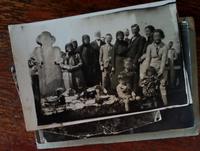
Commemoration of the dead by a family in Bessarabia
The photograph shows a family from Bessarabia in a cemetery of Chilia Nouă celebrating Paștele Blajinilor (in Romanian) or Radonitsa (in Russian), the day when the Orthodox Christian families commemorate their deceased relatives. Almsgiving has a central place in the commemoration of the dead in Orthodox Christian tradition. It is believed that by offering to each other bread, cookies, fruits, tableware items and drinks, the believers redeem the sins of their deceased relatives, and satiate the dead’s thirst and hunger. This is why the grave in the image is covered with various items that we -
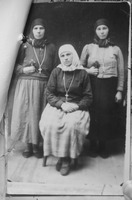
Confiscated photographs of Archangelists Moldova
These confiscated photographs come from a 1938 Military Court file from Romanian Bessarabia (today’s Republic of Moldova). On the 25th August 1938, a house search was conducted of the home of Vladimir Draguțan in the village of Recea, county Lăpușna. Amongst the items “used for Inochentist propaganda” discovered at Vlademir’s home were a number of religious booklets, devotional images of Alexandru Culeac, the founder of the movement, and Inochentie of Balta, a number of small crosses and several photographs of the community. The first image shows three women one of whom is named in the case f -

Inventory and confiscated items from a house search of an Archangelist-Inochentist Romania
The images show an inventory and confiscated photographs included in a case file forwarded to the Romanian 3rd Army Military Court on 2nd December 1938. The first image shows the inventory of items found in the house, which was located in Fălciu county. The officer lists the following Inochentist "propaganda" materials: "1. A brochure entitled 'The Deeds of the Archangel Michael', 2. a small icon of saint Paraschiva, 3. a cross sculpted from wood, 4. three photographs of Culeac dressed in white with a cross on his chest, 5. a photograph of Culeac dressed in vestments." The second image shows o
